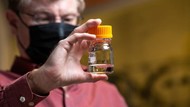News
Now Available: NREL State of Technology Report on Ex Situ Catalytic Fast Pyrolysis of Biomass
What advances have we made in the ex situ catalytic fast pyrolysis of biomass? Review research insights, technology improvements, and modeled cost savings and greenhouse gas emissions reductions in the latest state of technology report from the National Renewable Energy Laboratory (NREL).
ChemCatBio Researchers Participate in Butanediol Summit
The U.S. Department of Energy’s Bioenergy Technologies Office hosted a meeting on June 11 to coordinate research on 2,3-butanediol (BDO), a promising intermediate made from biomass sugars for producing sustainable fuels and chemicals. The goal of the summit was to share information across the BDO upgrading platform—from synthesizing BDO with sugar fermentation to catalytically upgrading it into sustainable aviation fuel. Contact Richard Elander, NREL’s biochemical platform manager, for more details about the summit.
New Major Version of CatCost Released
Version 1.1.0 of CatCost, ChemCatBio’s cost estimation tool for catalysts, was released earlier this year. The update includes sensitivity analysis, Excel-to-web conversion scripts built in Python, process templates, calculation and performance improvements, and more. Join a new CatCost mailing list to stay up-to-date with future updates—coming soon!
Upcoming Events
ChemCatBio Webinar—Reduce, Reuse, Recycle: Data Benchmarking and Accessibility for Faster Research With the Catalyst Property Database
Join Kurt Van Allsburg on October 13, 2021, 12–12:45 p.m. MDT for a webinar on the Catalyst Property Database (CPD). The CPD is a free, public resource designed in response to the observation that when data—such as computed reaction energetics—are used in catalyst design, they are almost always generated by the researchers seeking to use it, even if similar data have been published previously. This online event will cover the motivations for the CPD, how to search and upload data, applications, and future plans to grow types and quantity of data. Register for the webinar.
ChemCatBio-Hosted Symposium at the 2022 Spring ACS National Meeting
Abstracts are due October 11, 2021, for a ChemCatBio-hosted symposium at the American Chemical Society (ACS) national meeting. The panel will focus on reducing greenhouse gas emissions through catalytic conversion of renewable and waste carbon sources. The ACS Spring 2022 meeting—themed “Bonding Through Chemistry”—will be held March 20–24, both virtually and in person in San Diego, California.
Recent Research Highlights

National Renewable Energy Lab Research Behind Biggest Sustainable Fuel Agreement in Aviation History
United Airlines and Honeywell announced a joint investment in Alder Fuels, a startup working on a “first-of-its-kind” process for producing drop-in sustainable aviation fuel (SAF) that has a net-negative carbon footprint. United committed to purchase 1.5 billion gallons of SAF from Alder over 20 years—one and a half times the size of the known SAF purchase commitments of all global airlines combined. Among Alder's research partners is the U.S. Department of Energy's National Renewable Energy Laboratory—a key member of ChemCatBio—whose research on catalytic carbon transformation is opening new doors for converting organic waste and sustainable, non-food plant material into carbon-negative transportation fuels.
|

Jet Fuel from Renewable Sources Gains Efficiency Through Multi-Sector Collaboration
A patented process for converting alcohol sourced from renewable or industrial waste gases into jet or diesel fuel is being scaled up at the U.S. Department of Energy’s Pacific Northwest National Laboratory (PNNL) through a partnership with Oregon State University and carbon-recycling experts at LanzaTech. The project will use a one-fourth commercial-scale test reactor, produced by 3D printing. Supported by ChemCatBio expertise, a new PNNL-patented catalyst converts ethanol directly into a versatile “platform” chemical called n-butene. The new process would provide a more efficient route for converting renewable and waste-derived ethanol to useful chemicals, while reducing carbon dioxide emissions by using renewable or recycled carbon feedstocks.
|

Aviation Research at Oak Ridge National Lab Improves Ethanol-to-Jet-Fuel Outlook
Oak Ridge National Laboratory researchers have published an article in ACS Catalysis showcasing a catalyst capable of converting ethanol to jet fuel. The research team has been developing improved techniques for converting ethanol to C3+ olefins, which are intermediates for the production of aviation fuels. The unique composite catalyst used by the researchers achieves a higher yield of C3+ olefins than the current state of technology, thus reducing the cost of jet fuel production. These improved processes could make ethanol a substantially more competitive feedstock for the aviation industry.
|
The Accelerator is a newsletter of ChemCatBio, a consortium of eight DOE national labs dedicated to accelerating the catalyst and process development cycle for bioenergy applications. ChemCatBio is part of the Energy Materials Network, funded by the Bioenergy Technologies Office in DOE’s Office of Energy Efficiency and Renewable Energy.
|